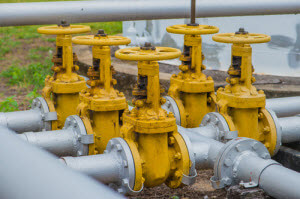Valves 101: The Ultimate Guide to Valves
With more and more advanced technologies being developed every day, it’s easy to forget that valves are still one of the most critical components in industrial plants. In fact, without the proper valves, systems are more to likely deteriorate and ultimately fail.
To prevent these catastrophic system failures, here’s your ultimate guide to valves to help you get a better understanding of some of the most important devices in your plant.
Basic Valve Information and Uses
Valves are mechanical devices used to regulate and control the flow of an industrial system or process. This means they can stop, start, or throttle flow. They can also increase or decrease the amount of pressure flowing through the system.
Valves are designed to work with a variety of materials as well. This includes liquids, gasses, vapors, and even corrosive materials. Because of their versatility, most valves are ideal for an array of industries, including the manufacturing industry, the petrochemical industry, and the compressed gas industry.
Types of Valves
However, not all valves are the same. Many different types of valves are designed to work with specific materials and provide a particular function. To help you understand which valve is right for you, here’s a breakdown of a few of the most common valves for industrial systems.
 Pressure Relief Valves
Pressure Relief Valves
Pressure relief valves prevent overpressure situations for high-pressure systems. They’re designed to gradually open depending on the system’s current pressure levels. When pressure increases, the valve opens more so more fluid can flow through. This helps to maintain appropriate pressure levels and ensures stable and safe operations.
- Globe Valves
Globe valves start, stop, and throttle the flow of the pipeline. The disc in the globe valve moves slowly from the seat to prevent vibrations and water hammer. Generally, companies use this valve as a regulating device and an on/off device.
- Check Valves
Check valves help systems to maintain flow in one direction. This two-port device uses a clapper that lifts to keep fluids flowing in the right direction. When pressure in the system begins to decrease or when the flow starts to reverse, the flapper closes the valve to ensure proper directional flow.
- Gate Valves
 Gate valves are designed to be on/off valves for industrial companies. They won’t regulate the flow or pressure within a system, but they’re known to have lower pressure drops when correctly installed.
Gate valves are designed to be on/off valves for industrial companies. They won’t regulate the flow or pressure within a system, but they’re known to have lower pressure drops when correctly installed.
- Ball Valves
Ball valves use a rotating ball to open and close so they can transfer various types of materials through a system. They’re known to be fast-acting valves, which makes them ideal for any start/stop application.
Materials and Selection
All valves are made with different types of materials. Depending on the application, you’ll need a valve made of a specific material to ensure proper operation. For example, if you’re looking for something that can withstand corrosion, you’ll need to choose a valve made of nickel alloys or other durable metals.
To ensure that you select the right valve for your system, consider the application and the type of liquid or gas through the system. This will help you understand what type of valve you need as well as which material will work best for your needs.
Valves are essential parts of any industrial system. If you’re looking for a high-quality valve for your company, check out CPV Manufacturing’s catalog of pressure relief, check, and gate valves. As a leading valve manufacturing company, CPV can provide you with the necessary insight to purchase the right products for your projects.
